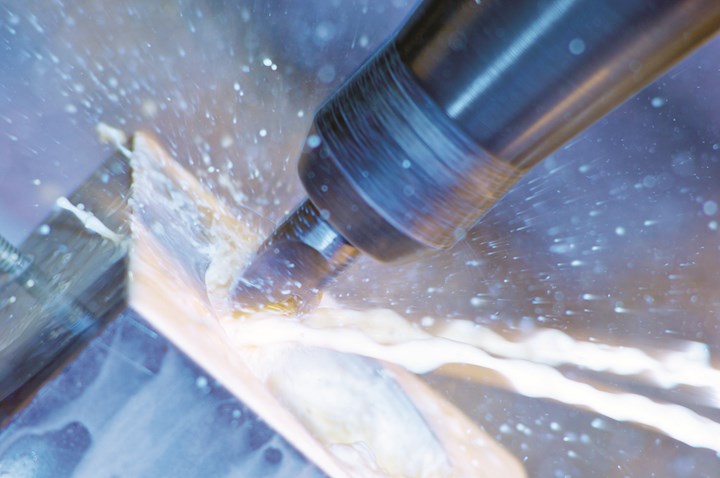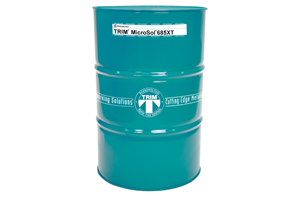Some experts say the cost of perishable lubricant is 1.4% of total sales. In comparison, perishable tooling costs average about 6%. With the cost of a quality coolant at $1,500+ per drum, how can it have such a low impact on the bottom line? The real cost needs another look, but getting there takes some effort.
We recently sat down for a Q&A with Joe Gentile, product manager at Hangsterfer’s Laboratories Inc., to discuss the true cost of metalworking fluids. He provided some real-life examples to show it may be far more significant than many shops think.
PM: Why are shops quick to overlook the impact of their lubricant costs?
JG: If a shop questions the effectiveness of its tooling strategy, it can relatively easily test a new tool with the potential to quickly impact the bottom line. In contrast, emptying a machine, cleaning it and refilling with a new lubricant for testing could require a minimum of three machine hours. They find it hard to justify that time and work.
PM: What is your position on testing lubricants?
JG: As product manager at Hangsterfer’s Labs for more than 20 years, I’m firmly on the side of advocating testing. However, in my previous life as a shop owner (and manufacturing engineer and programmer), I had the added responsibility of ensuring the manufacturing process was profitable and sustainable. As the part or parts were being programmed, we were acutely aware of the machine time and the quoted time differences.
My partner (and brother) did most of the quoting and passed along the expected production time with the job trailer. When the jobs got to the operation planning stage, we would discuss whether to look to new technology to produce the parts for more reasonable profitability. We would review equipment and machining strategies and consider the most effective tooling. But the lubricant was a constant.
Often, cycle time did not come into question until a part was successfully produced on the machine. Once the programming system provided a cycle time, if it was not sufficient or if we could not achieve acceptable tool life, we would begin looking at other tooling alternatives. Unfortunately, we continued to overlook the effects of the lubricant.
We later discovered that the biggest improvements in cycle time, tool life and overall part quality came with adjustments to the lubricant. Looking at alternative coolants and oils became part of our cycle optimization procedure.
PM: Is there a specific example that sold you on the idea of considering alternative coolants while being a shop owner?
JG: The head turner was a titanium job (TI6AL) that required face milling, then a finish end mill operation. The lube netted one pass of the face mill, which had a six-insert, high double-angle positive rake for our 7-hp spindle. We had a critical issue because the cost of the inserts, while they were correct for the operation, was higher than what was quoted for the entire job. The cutter seemed the best that our machine could handle. Our only option was to consider a new coolant or lube.
We contacted Hangsterfer’s, who recommended we replace the coolant with a cutting oil. The change required modification of the CNC mill’s coolant pump to get more oil volume to help prevent smoke and mist, but no question, the oil saved the job. Instead of one pass, we got the entire job—120 pcs (five passes each)—on three sets of inserts.

A shop should maintain direct access to its metalworking lubricant supplier to stay current with the latest chemistry developments.
PM: How does a shop know where to go for coolant options?
JG: Most shops have a direct line to the tooling distributor/supplier they trust for easy access to the most recent tool material technology. The shop should also maintain a similar relationship with a metalworking lubricant supplier. Being informed and having access to bleeding edge chemistries can maximize tool life, profits and part quality.
PM: How is the overall coolant cost determined?
JG: It clearly goes beyond the initial pricing. Shops should also consider some long-term incidental costs that are not included there. Operator acceptance would fall into this category, along with machine maintenance from various effects such as residue, elastomer wire cover failure, machine bare metal rust and paint removal.
Costs include all the shop time involved, whether it directly costs machining time or if it is done while the machine is running. In my previous example, the numbers were far higher than what the cost experts claimed. Total manpower hours seemed more like 6% of total billing—directly related to overall manhour costs along with the machine time costs and the price of the product. Low or competitive part costs will increase the percentages.
PM: How do other shop costs tie into that of the lubricant?
JG: As stated earlier, some experts estimate the cost of tooling at about 6% while the cost of lubricant is a little more than 1%. With those figures, saving even 1% on tooling cost should balance out the lubricant cost. Even at the highest cost per gallon/liter, initial lubricant cost should never be more than 2% of total sales. It goes to reason that if you save 3% of tooling costs, you seriously improve your bottom line.
It’s said the best bottle of wine is the $10 bottle that you enjoy—the most expensive isn’t necessarily the best. The same goes for lubes and a shop’s processes. Getting the right lube for the job can pay off handsomely. But the testing should go further than only the tool life extension. It should also include cycle time study of the speeds and feeds. “More feed, more speed!” is the cry of most shops in their efforts to enhance profits. Testing new lubricant technology the way a shop tests a new tool can have a significant effect on the bottom line.
PM: What are some other general considerations?
JG: In most small shops, the manufacturing engineer and the programmers are the same. First order of business is to get the job running; then they optimize the job to the machine, tools and the lubricant. If one of these is not performing well, the parts still need to be made. How much adjusting is going on to get the job running instead of innovating with new technology in tools or lubricant? The only way to know is by testing new products in a consistent format with known parameters.
Some large companies have invested in exploratory shop environments such as OMIC (Oregon Manufacturing Innovation Center) and AMRC (Advanced Manufacturing Research Centre), where lab quality data is obtained that can be shared with a customer, documenting both tooling and lubricant performance. Consistency in any manufacturing facility is important, but improved process throughput is equally important and affects profit. Those few hours taken to clean out a machine to test a coolant or oil could net considerably more than the lubricant and the cost of the time.
Hangsterfer’s Laboratories Inc. | 800-433-5823 | hangsterfers.com
Related Content
Automating Cutting Fluid Management
Automation can amplify the benefits of cutting fluid management while reducing the maintenance burden on shopfloor employees.
Read MoreFluidLynx Offers Intelligent Cooling Lubricant Automation
PMTS 2023: Motorex’s FluidLynx automated fluid management system offers controllable and traceable process reliability, while better protecting workpieces and machines, and optimizing tool life.
Read MoreHennig Inc. Acquires Industrial Coolant Systems
ICS develops and field tests high-pressure coolant systems, coolant filtration systems and other machine tool solutions.
Read MorePrecision Machining Technology Review September 2023
Production Machining’s September 2023 technology showcase includes some of the latest technology from Lyndex-Nikken Inc., Kurt Workholding, Master Fluid Solutions, Rego-Fix Tool Corporation and Jorgensen Conveyor & Filtration Solutions.
Read MoreRead Next
A Guide to Metalworking Fluids
The oils, coolants and lubricants used in metalworking shops are often overlooked as an opportunity to improve process efficiencies.
Read MoreEmerging Leaders Nominations Now Open
Here’s your chance to highlight a young person in your manufacturing business who is on the path to be a future leader moving your company forward.
Read MoreA Tooling Workshop Worth a Visit
Marubeni Citizen-Cincom’s tooling and accessory workshop offers a chance to learn more about ancillary devices that can boost machining efficiency and capability.
Read More























